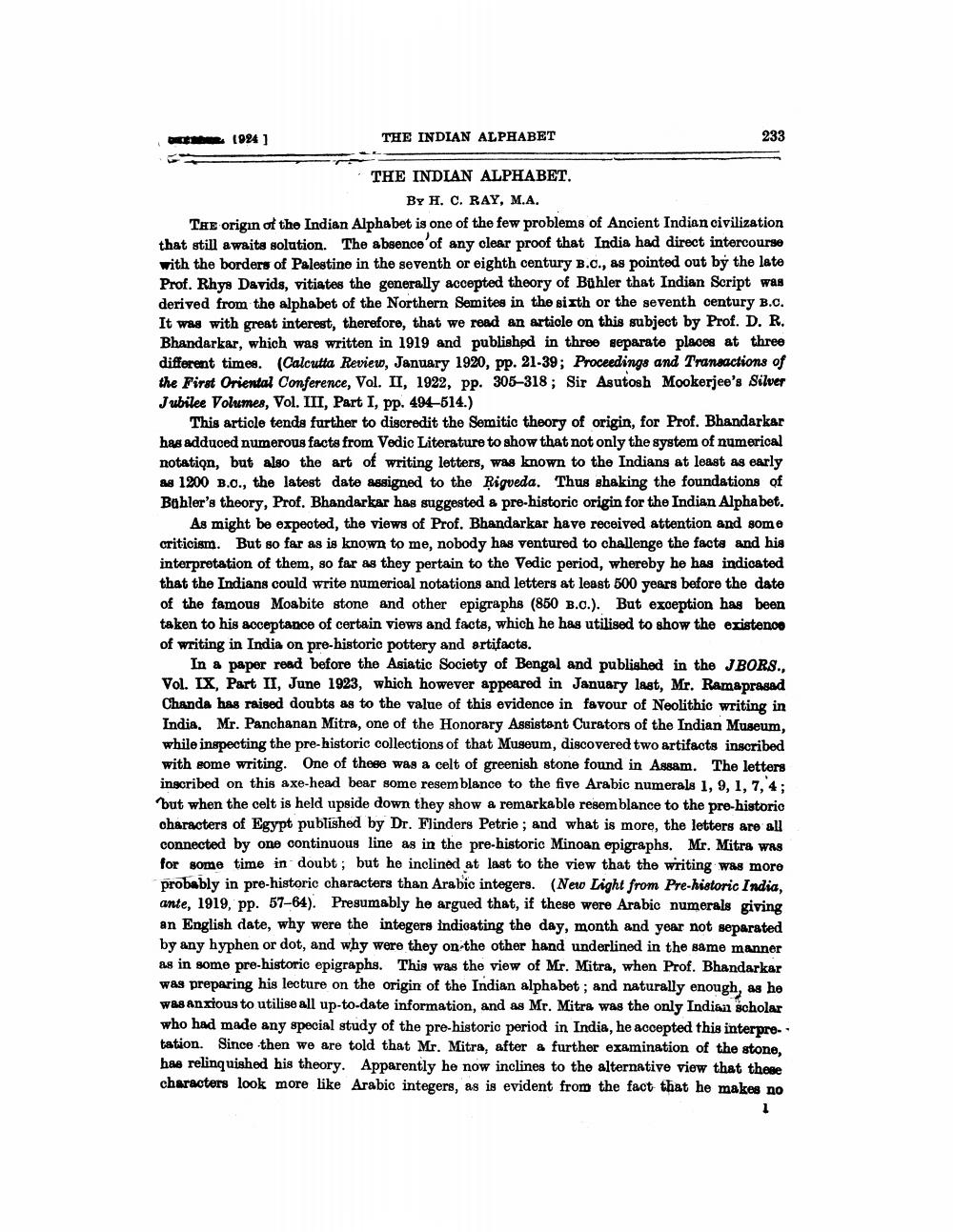________________
e
(924 ]
THE INDIAN ALPHABET
233
· THE INDIAN ALPHABET.
BY H. C. RAY, M.A. The origin of the Indian Alphabet is one of the few problems of Ancient Indian civilization that still awaits solution. The absence of any clear proof that India had direct intercourse with the borders of Palestine in the seventh or eighth century B.C., as pointed out by the late Prof. Rhys Davids, vitiates the generally accepted theory of Buhler that Indian Script was derived from the alphabet of the Northern Semites in the sixth or the seventh century B.C. It was with great interest, therefore, that we read an article on this subject by Prof. D. R. Bhandarkar, which was written in 1919 and published in three separate places at three different times. (Calcutta Review, January 1920, pp. 21-39; Proceedings and Transactions of the First Oriental Conference, Vol. II, 1922, pp. 305-318; Sir Asutosh Mookerjee's Silver Jubilee Volumes, Vol. III, Part I, pp. 494-514.)
This article tends further to discredit the Semitic theory of origin, for Prof. Bhandarkar has adduced numerous facts from Vedic Literature to show that not only the system of numerical notation, but also the art of writing letters, was known to the Indians at least as early 48 1200 B.O., the latest date assigned to the Rigveda. Thus shaking the foundations of Bohler's theory, Prof. Bhandarkar has suggested & pre-historic origin for the Indian Alphabet.
As might be expected, the views of Prof. Bhandarkar have received attention and some criticism. But so far as is known to me, nobody has ventured to challenge the facts and his interpretation of them, so far as they pertain to the Vedic period, whereby he has indicated that the Indians could write numerical notations and letters at least 500 years before the date of the famous Moabite stone and other epigraphs (850 B..). But exoeption has been taken to his acceptance of certain views and facts, which he has utilised to show the existence of writing in India on pre-historic pottery and artifacts.
In a paper read before the Asiatic Society of Bengal and published in the JBORS., Vol. IX. Part II, June 1923, which however appeared in January last, Mr. Ramaprasad Chanda has raised doubts as to the value of this evidence in favour of Neolithic writing in India, Mr. Panchanan Mitra, one of the Honorary Assistant Curators of the Indian Museum, while inspecting the pre-historic collections of that Museum, discovered two artifacts inscribed with some writing. One of those was a celt of greenish stone found in Assam. The letters inscribed on this axe-head bear some resemblance to the five Arabic numerals 1, 9, 1, 7, 4; but when the celt is held upside down they show a remarkable resemblance to the pre-historic characters of Egypt published by Dr. Flinders Petrie ; and what is more, the letters are all connected by one continuous line as in the pre-historic Minoan epigraphs. Mr. Mitra was for some time in doubt; but he inclined at last to the view that the writing was more probably in pre-historic characters than Arabic integers. (New Light from Pre-historic India, ante, 1919, pp. 57-64). Presumably he argued that, if these were Arabic numerals giving an English date, why were the integers indicating the day, month and year not separated by any hyphen or dot, and why were they on the other hand underlined in the same manner as in some pre-historic epigraphs. This was the view of Mr. Mitra, when Prof. Bhandarkar was preparing his lecture on the origin of the Indian alphabet ; and naturally enough, as he was anxious to utilise all up-to-date information, and as Mr. Mitra was the only Indian scholar who had made any special study of the pre-historic period in India, he accepted this interpretation. Since then we are told that Mr. Mitra, after a further examination of the stone, hae relinquished his theory. Apparently he now inclines to the alternative view that these characters look more like Arabic integers, as is evident from the fact that he makes no




